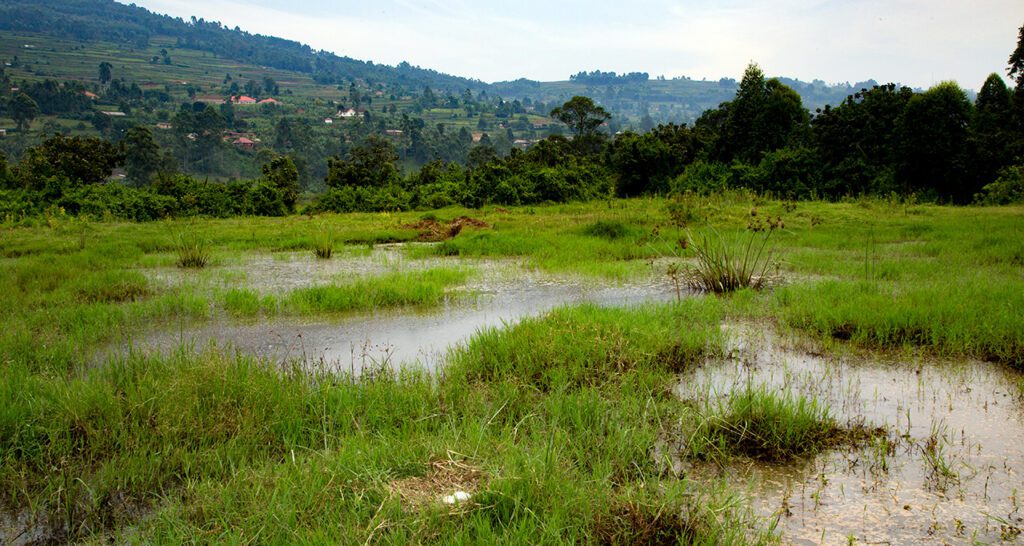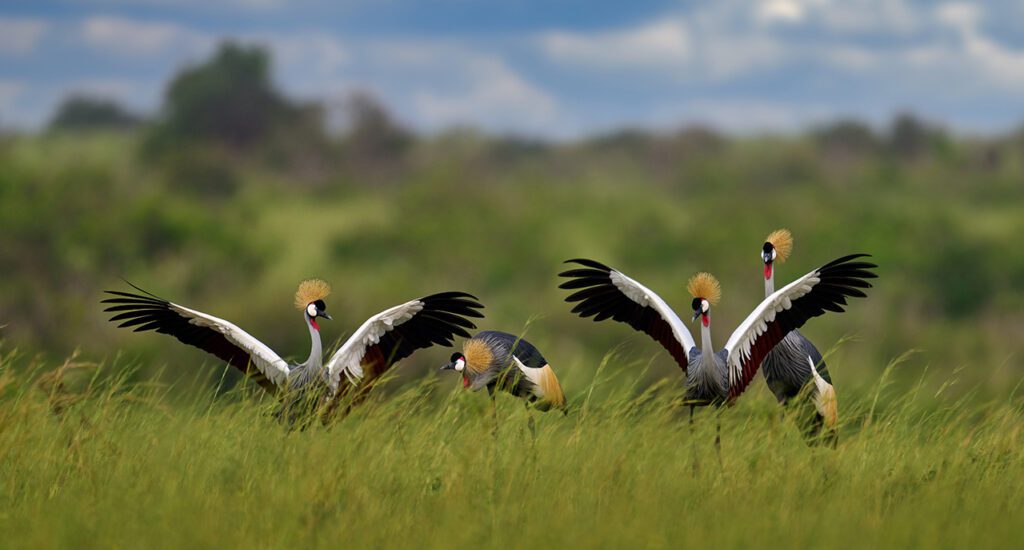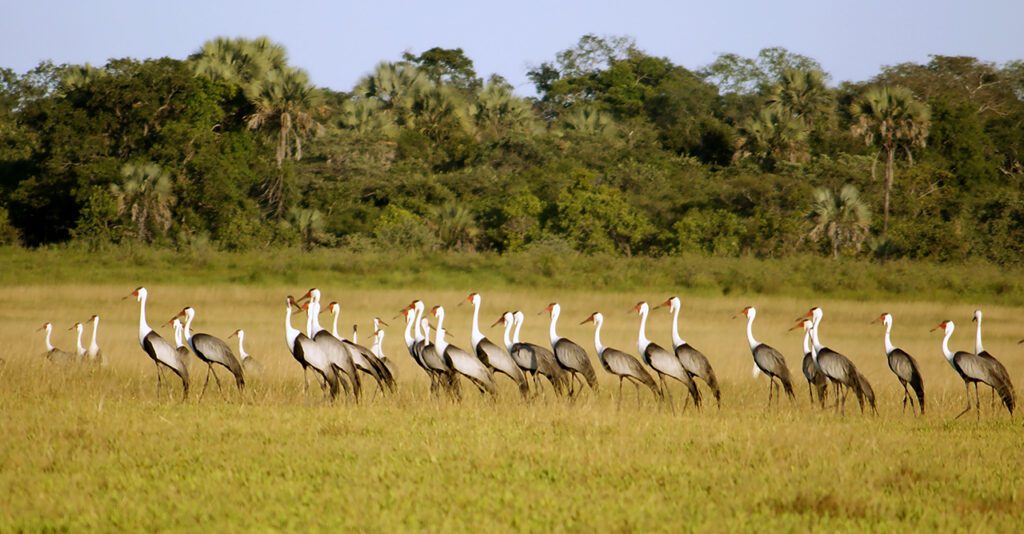Partnerships Provide Safe, Fresh Water for Communities and Cranes in Kenya
CONTACT: Jodi Legge, Vice President of External Affairs, 608-356-9462, ext. 114
International Crane Foundation Installs Six Springs in Nandi County with More Needed
Aug. 29, 2024 (Kenya, Africa) – The International Crane Foundation installed six freshwater springs in Nandi County, Kenya, this year, providing more than 5,000 families with fresh water, thanks in part to a one-million-dollar commitment from the Leiden Conservation Foundation and the support from the local communities and governments. Families throughout Nandi County rely on water for domestic use and to care for their livestock, yet 54 percent of people in this county do not have access to safe water.
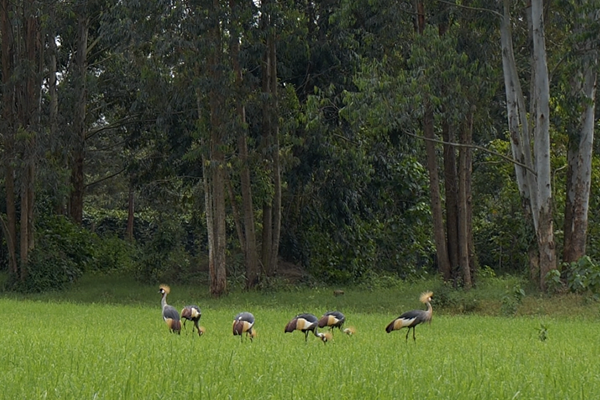
Grey Crowned Cranes forage near a wetland buffer zone in Kenya. Traditionally, local communities collect water in wetlands, which disturbs the cranes that use these areas for feeding and breeding grounds. Ufulu Studios photo
“We believe access to clean water is a fundamental human right,” said Eva Tokoi, Senior Field Officer for the International Crane Foundation in Kenya. “Yet, millions of people around the world lack this basic necessity.”
Tokoi noted many Nandi County residents, especially women and children, must travel miles from home into the wetland to collect water from open springs, sometimes having to sacrifice time in school to fetch the water needed. However, not only is this water unsafe to drink unless treated, but it also disturbs the wetland area, an important resource for the community and a feeding and breeding ground for the Endangered Grey Crowned Crane.
The spring project involves collecting water from an eye of the spring and providing free access to the site to everyone that needs clean water. The eye of a spring is the point where water from an underground spring emerges at the surface of the ground. Springs can form when the water table, or the top level of groundwater, meets the surface. The water can flow out of a single hole or seep out along a line. Sites are selected based on their durability, the likelihood of the spring benefitting many people, acceptance and ownership from the local community, and the presence of Grey Crowned Cranes. The innovative design is cost-effective, low-maintenance, and is built for long-term sustainability.
Once the sites are selected, a community group is set up to manage the project using a phased approach. The group first sets goals, then helps with land siting, legal issues, and water quality tests. This involves building a filtration system as designed by the county water department with a simple mechanism to ensure the water is clean.
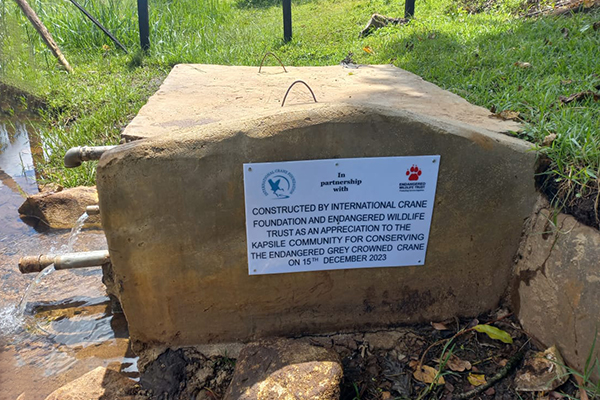
The new spring’s plaque reads: “Constructed by International Crane Foundation and Endangered Wildlife Trust as an appreciation to the Kapsile Community for conserving the Endangered Grey Crowned Crane.” Eva Takoi/International Crane Foundation
Before construction, the immediate area at the discharge is excavated and filled with rocks and gravel of different sizes to filter the water. A block wall is then constructed to hold the excavated area, after which a collecting water tank is built. Next, pipes are built. This includes the overflow pipes located near the top of the tank; a water fetching pipe located in the middle where community members can collect the water; and a washout pipe – located at the bottom of the tank (for use when washing the tank). This structure ensures surface flow does not enter the water tank to avoid contamination.
“This approach brings ownership and sustainability to each project,” said Tokoi.
Each site costs between $3,500 and $4,000 (U.S. dollars) for construction materials. The Foundation has the capacity to build 10 springs per year; however, the current budget only allows for two or three per year. “We would love to expand our ability as funding allows,” said Tokoi, “and we are always looking for donors willing to support our work in Kenya.”
The six springs already installed have provided clean water to families, schools, churches, hospitals, and shopping centers. With access to fresh water, the Foundation is reporting less disturbance in the wetlands and a higher percentage of crane habitat for breeding. The partnership has other community benefits as well – including less crane poisoning reported, community members caring for crane nesting sites, and overall improved tolerance to cranes throughout Nandi County.
“All species thrive when we work together,” said Tokoi.
